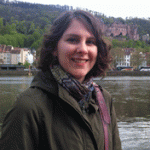Baldock – Question 3
April 2014
3How do you reconcile originality or creativity with values and practices often central to archival representation such as “authentic” or “faithful” representations of source materials and respect des fonds?
Sophie Baldock
British Library Scholarship Student and PhD Student in English – University of Sheffield
¶ 1 Leave a comment on paragraph 1 0 One of the most challenging questions for archivists working with born-digital materials is how to reconcile an archive’s born-digital form with existing and entrenched methods of archival arrangement and representation, which in most cases were conceived with paper records in mind. In my view, archivists must develop new and creative strategies to represent the contents of born-digital archives to researchers who wish to use them and need a guide to their contents. These strategies may not always fit easily with traditional archival values and practices.
¶ 2 Leave a comment on paragraph 2 0 Born-digital materials, I would argue, do not require the same level of archival description as paper. While paper archives often require a detailed catalog and description of their contents, the born-digital form of an email archive like Wendy Cope’s at the British Library may render further description or arrangement by an archivist redundant. Furthermore, the size of an email archive (in Cope’s case about 40,000 emails) often makes detailed description impossible. In some senses, Wendy Cope’s emails arrived in the archive already cataloged. Messages were arranged in chronological order, each one containing the exact date and time it was sent or received. It was also possible to perform full-text searches of the entire email archive and pinpoint the exact location of material required, for example, email exchanges that mention the titles of particular poems.
¶ 3 Leave a comment on paragraph 3 0 I concluded that it would be more “authentic” for a researcher to encounter an email archive like Wendy Cope’s unmediated by any external catalog, and browse through it in much the same way that its creator would have. Some cataloging data was needed to give researchers a broad picture of what the email archive contains, and how it is organized, but not the same detailed item-level description as a paper archive. In addition to this, tools such as metadata extraction—whereby information such as numbers of emails, digital extent, and date-range is automatically extracted—can be used to populate a catalog record.
¶ 4 Leave a comment on paragraph 4 0 Born-digital archives also call into question the applicability of respect des fonds as an organizing principle.1 In essence, respect des fonds dictates that archival records be grouped together according to the person/s or organization that created them. However, what an email archive makes abundantly clear is the way that individual archives overlap. A large proportion of an email archive is necessarily made up of messages from other people, making it difficult to see where one person’s archive begins and another’s ends. Libraries and archives are starting to think outside the limitations of the fonds principle, and are using cataloging metadata to demonstrate the way that separate collections connect. See, for example, the Social Networks and Archival Context Project (SNAC), which uses archival authority files held in separate libraries (including records from the British Library and other major institutions in Europe and the United States) to link together and visualize information about individuals and their social and professional networks.2 As modern archives become increasingly digital, I think it will be crucial for libraries and archives to allow their users to explore these links.
- ¶ 5 Leave a comment on paragraph 5 0
- See, for example, Jefferson Bailey’s argument in “Disrespect des Fonds: Rethinking Arrangement and Description in Born-Digital Archives,” Archive Journal 3 (2013), http://www.archivejournal.net/issue/3/archives-remixed/disrespect-des-fonds-rethinking-arrangement-and-description-in-born-digital-archives/. [↩]
- SNAC: The Social Networks and Archival Context Project, accessed October 2013, http://socialarchive.iath.virginia.edu/news.html. [↩]


0 Comments on the whole post
Leave a comment on the whole post
0 Comments on paragraph 1
Leave a comment on paragraph 1
0 Comments on paragraph 2
Leave a comment on paragraph 2
0 Comments on paragraph 3
Leave a comment on paragraph 3
0 Comments on paragraph 4
Leave a comment on paragraph 4
0 Comments on paragraph 5
Leave a comment on paragraph 5